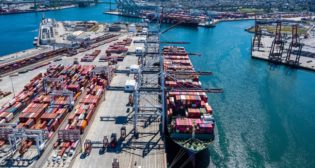
Shippers ask STB to deliver a free lunch
Written by William C. Vantuono, Editor-in-ChiefThe expectation is lower freight rates—a free lunch, requiring railroads provide something in exchange for nothing. A more likely outcome is higher overall transportation costs, service quality reduction, a flight of investment capital, and perpetual railroad revenue inadequacy.
The NITL and ACC want federally mandated reciprocal switching, a scheme requiring that, where a single railroad now serves a shipper facility, that railroad be required, on shipper demand, to transfer a shipper’s loaded freight cars to a second railroad so long as that second railroad’s tracks are within a 30-mile radius of the shipper’s facility.
If the railroad serving the shipper facility chooses to lower its freight rate, the transfer wouldn’t be demanded. However, if the lone railroad serving the shipper facility declines to lower its freight rate, the second railroad is assumed to offer a lower price and snatch the business. Either way, the objective is to force freight rates lower, reducing railroad revenue by as much as $1.2 billion annually, according to the ACC.
Hey, who is against lower prices generated by competition? Amazon.com and Walmart are to be praised for their marketing and sales genius. But railroads have remarkably different cost structures than Internet marketing firms and big-box department stores.
Economics explains why the NITL/ACC proposal is a prescription for reinstating the sclerosis that sent the rail industry hurtling toward financial failure in the 1970s—a near national calamity that wasn’t reversed until the Staggers Rail Act of 1980 restored market forces in place of federal micro-managing of railroad freight rates.
For network industries with high fixed costs—such as railroads—hundreds of billions of dollars must be invested before the first carload of freight may be transported, and for a railroad to recover those high fixed costs, not all customers can or should be treated equally. If fixed costs are not recovered, investors flee, maintenance is deferred, capital renewal is postponed, service quality declines, and shippers most dependent on rail service eventually suffer.
Because these sclerotic effects take years to materialize, some shippers have a short-term self-interest in schemes such as mandatory reciprocal switching. The incentive is not too dissimilar from that of politicians who mask government financial imbalances to improve reelection opportunities without concern to the harm their successors inherit and future taxpayers bear.
Railroads exhibit very high fixed cost investments—$500 billion since 1980 and some $13 billion budgeted for 2013—in track, signals, bridges, tunnels, and equipment before a single carload of freight may be transported. The additional marginal costs (out-of-pocket expenses) such as fuel, routine maintenance, train crews, and administration for transporting additional freight cars is relatively low compared to fixed costs. Thus, charging all available freight traffic a price slightly above marginal cost prohibits recovery of all fixed costs and results, eventually, in bankruptcy.
Enter the concept of differential pricing.
Shippers most dependent on railroads pay freight rates considerably higher than marginal costs to ensure a minimum level of service quality. To ease that burden on rail dependent shippers, those shippers who readily and alternatively may move freight via truck or barge are charged a lower freight rate—but still more than marginal cost—to attract that freight and make some contribution to recovery of fixed costs.
Those lower contributions to fixed costs paid by shippers less dependent on rail service benefit the more rail dependent shippers as the prices charged rail dependent shippers would be even higher if they were the only ones utilizing the railroad.
Mandatory reciprocal switching would lower the additive over marginal costs paid by rail-dependent shippers; but, according to the NITL and ACC, result in more rail freight traffic to help cover fixed costs. That assumption is fallacious.
Rail dependent shippers, by definition, are without truck and barge alternatives, so unless they dramatically increase production, they would not provide additional freight traffic. Indeed, manufacturers increase production not because of lower rail rates, but because of increased demand for the products they manufacture.
And were railroads to increase freight rates they charge shippers with truck and barge alternatives to cover the fixed-cost shortfall created by mandatory reciprocal switching, those shippers would switch to truck and barge, increasing the fixed-cost burden on rail dependent shippers.
Furthermore, the NITL and ACC ignore the substantial additional costs of mandatory reciprocal switching, which can triple the number of discrete freight car movements, increase dwell time, slow product delivery, require additional locomotives and train crews, necessitate expansion of switching facilities, and increase fuel use and environmental pollution.
Most important here is that rail dependent shippers are not at the unbridled mercy of railroads. The Staggers Rail Act did not fully deregulate railroads. If a rail rate exceeds a statutory threshold, regulators already can prescribe a maximum rate retroactively. In fact, of 45 shipper complaints filed with the STB since 1996, 37 of the complaints were decided in favor of shippers or settled voluntarily.
Additionally, the Staggers Rail Act provides that the STB “may require” reciprocal switching if a pattern of anti-competitive conduct is demonstrated. The NITL and ACC prefer that even without a showing of anti-competitive conduct, Class I railroads should be compelled to engage in mandated reciprocal switching—regardless of the longer-term economic harm.
Rail dependent shippers have another recourse. They may construct new facilities where two-railroad competition is available, expand production at facilities already served by multiple railroads, or even close plants served by just one railroad. Even the threat of such action is an effective shipper tool when negotiating freight rates.
With no demonstrable evidence that railroads are engaging in a pattern of anti-competitive conduct where just one carrier serves a shipper facility, the demand for universal mandated reciprocal switching constitutes nothing more than a desire for a temporary free lunch. It is the longer-term draconian economic consequences that require the NITL/ACC petition to be relegated to the dust bin of history.
The matter is docketed before the STB as Ex Parte 711, Petition for Rulemaking to Adopt Revised Competitive Switching Rules.



